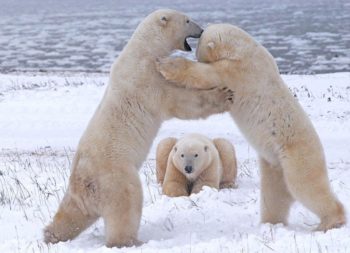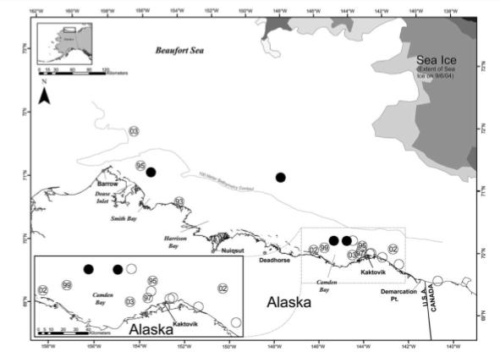
Dr. Willie Soon*: Yes, indeed. I have argued that too much ice will be the ultimate enemy for polar bears. Polar bears need less sea ice to be well fed and to reproduce.
Why? Think about this for a minute: Polar bears eat a lot. Any large colony will need a great deal of food. The bears’ staple diet is seal blubber. But seals are a long way up the food chain.
So a fully functional and healthy eco-system is required. And that means oceans warm enough to support the lower links in the food chain from plankton all the way up to seals.
Indeed, a good puzzle for polar bear science is to answer the question how polar bears survived during the Ice Ages when ice covered coastal zones and large parts of the global ocean.
Ice was piled miles deep on land, making it extremely difficult for eco-systems to provide enough food. Of course, areas of relative warmth, which population biologists call refugia, always exist.
They may well be the key to explaining how polar bears survived the Last Glacial Maximum about 21,000 years ago.
The so-called “environmentalists,” who seem to allow unreasoning emotion and political prejudice to stand in place of rational thought and sound science, became very angry when I asked them whether they would prefer to see a billion polar bears instead of the 20,000–30,000 living now.
The real threat to polar bears was unregulated hunting, which reduced the population to perhaps as few as 5,000 bears in the early 1970s.
After the November 1973 agreement to regulate hunting and outlaw hunting from aircraft and icebreakers, the polar bear population rebounded. By 2017 it was approaching 30,000.
In 2016, a survey by the Nunavut government found a vulnerable population in the western Hudson Bay region to have been stable for at least five years.
I should say categorically that this polar bear fearmongering is evidence of mass delusion promoted by groupthink.
As a physical scientist rather than a biologist, I am generally reluctant to get involved in such topics as the influence of climate on polar bear population, health, and biology.
But in 2002, Markus Dyck asked me to independently examine these strange and insupportable claims by environmental extremists that polar bears are threatened with extinction by global warming.
Consider the facts. From 6,000 to 10,000 years ago, the Earth was considerably warmer than today. Yet the polar bears survived.
In fact, they had evolved from land-based brown bears some 150,000 to 200,000 years ago, and to this day they rear their cubs in land-based dens burrowed into the snow.
Four dead bears found in an aerial survey of the Beaufort Sea (Monnett & Gleason, 2006)
Readers curious about Al Gore’s false statement that a scientific survey had found polar bears drowning because they could not find ice should see my talk on how environmentalists are the real threat to polar bears.
https://www.youtube.com/watch?v=AmoKRz5VcbI
The survey cited by Gore in his sci-fi comedy horror movie, in fact, found that just four polar bears had drowned, three of them very close to land, and they had died because of high winds and high waves in an exceptional Arctic storm.
The authors of the paper were later victimized by their academic colleagues at the instigation of environmental extremists because they had stated – correctly – that it was the storm, and not global warming, that had killed the bears.
What is more, in the dozen years before the survey, the sea ice extent in the Beaufort Sea, where the survey took place, had actually increased slightly. At no point was Al Gore’s story true.
In 2007, the High Court in London condemned Gore for his false statements about polar bears, whose Linnaean classification is Ursus maritimus – the Bear of the Sea.
It is now known that they can swim for more than 100 miles over periods of several days. Al Gore could not even ride a pushbike that far.
One positive aspect of my work in science is that I have befriended many seekers after truth. A polar bear expert, Professor Mitch Taylor of Lakehead University, told me late in 2017:
Just finished up in the Davis Strait with 275 DNA samples. The bears were in better condition this year than they were during the 2005–2007 study years.
The Wrangel Island bears in the photo are in good condition, but the Davis Strait bears were even fatter.
Markus [Dyck] has found the same in the Cape Dyer area. Local people confirm the bears are very fat this year and are also reporting a big increase in ringed seals (immigration, not local productivity).
Keen readers who may want solid information and frequent scientific updates about the overall health and trends of all 19 subpopulations of polar bears should visit the website of another friend of mine, Dr. Susan Crockford: http://polarbearscience.com.
*Dr. Willie Soon is an independent solar physicist at the Harvard-Smithsonian Center for Astrophysics who has been studying the Sun and its influence on the Earth’s climate for more than a quarter of a century.
A short while ago, he had a conversation with Mr. Grégoire Canlorbe, an independent journalist who is also vice president of the French Parti National-Libéral (“National-Liberal Party,” conservative, nationalist, and free-marketist).
Read rest of interview at Friends Of Science



















We all know that climate change is a political movement. The “science” that supports it ignores fact such as “From 6,000 to 10,000 years ago, the Earth was considerably warmer than today.”
Since the Greens use this eater of baby seals and goslings as a mascot for their Global Warming/Climate Change hoax to appeal to the school kids get them to persuade their parents into Going Green over this Global Warming/Climate Change poppycock
Don’t forget that polar bears are among the few species on earth that prey on humans.